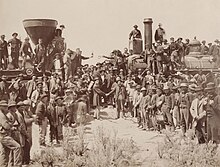Transport/History
Appearance

The first known transportation was walking, humans began walking upright two million years ago with the emergence of Homo Erectus (meaning upright man). Their predecessors, the Australopithecus did not walk upright as habitually. Bipedal specializations are found in Australopithecus fossils from 4.2-3.9 million years ago, although Sahelanthropus may have walked on two legs as early as seven million years ago.
- 7000BCE earliest known shoes were bark sandals found in Oregon, US.[1] Although it is likely shoes have been in use much earlier but made from perishable materials. Somewhere between 40,000 years ago and 26,000 years ago based on observations of toe bone development.[2]
- 6000BCE dugout canoes invented. They are the oldest boat type archaeologists have found.[3] Fitted with outriggers, they early uses were by Austronesian-speaking people of the islands of Southeast Asia.
- Oxen are thought to have first been harnessed and put to work around 4000 BC.[4] For millennia, oxen also could pull heavier loads because of the use of the yoke, which was designed to work best with the neck and shoulder anatomy of cattle.
- Horses were domesticated and sedan chairs in use around 3500BCE.[5][6][7]
Wheel and axle
[edit | edit source]- The wheel was invented originally for pottery, as the potters wheel in 4200 BCE. It was the axle and wheel invented in 3500 BCE that revolutionised transportation.
- 3000 BCE - Austronesians construct catamarans and outriggers. In the Mediterranean, galleys were developed about 3000 BCE.
- The wheel and axle combined with domesticated oxen originally and later domesticated horses led to carts being mentioned in literature as early as 2000BCE. Chariots were used in the Indus Valley civilisation in 1900 BCE. Chariots were in use in warfare in Ancient Greece and Ancient Rome. The latter also developed wheeled carriages (or coaches) and wagons for civilian transport.
- In the 7th to 8th Century use of the horse collar was widespread across Europe.
Ancient transport in antiquity lasted until the modern era.
Early unmechanized pioneers of modern transport
[edit | edit source]

- The first public transportation predated mechanisation with horse-drawn omnibuses travelling bus routes in Paris in 1662.
- In 1783 the first manned flight was made in a hot-air balloon by the Montgolfier brothers, also in France.
Questions
[edit | edit source]Describe walking, pedestrianism, shoes in the context of transport. Are toy models of transport part of the history of transport?
References
[edit | edit source]- ↑ Connolly, Tom. "The World's Oldest Shoes". University of Oregon. Archived from the original on July 22, 2012. Retrieved July 22, 2012.
- ↑ Trinkaus, E.; Shang, H. (July 2008). "Anatomical Evidence for the Antiquity of Human Footwear: Tianyuan and Sunghir". Journal of Archaeological Science. 35 (7): 1928–1933. doi:10.1016/j.jas.2007.12.002.
- ↑ 1000 Inventions and Discoveries, by Roger Bridgman
- ↑ "HISTORY OF THE DOMESTICATION OF ANIMALS". Historyworld.net. Archived from the original on November 24, 2012. Retrieved September 17, 2012.
- ↑ Matossian, Mary Kilbourne (2016). Shaping World History. Routledge. p. 43. ISBN 978-1-315-50348-6.
- ↑ "What We Theorize – When and Where Domestication Occurred". International Museum of the Horse. Archived from the original on 19 July 2016. Retrieved 27 January 2015.
- ↑ "Horsey-aeology, Binary Black Holes, Tracking Red Tides, Fish Re-evolution, Walk Like a Man, Fact or Fiction". Quirks and Quarks Podcast with Bob Macdonald (CBC Radio). 2009-03-07. http://www.cbc.ca/quirks/episode/2009/03/07/horsey-aeology-binary-black-holes-tracking-red-tides-fish-re-evolution-walk-like-a-man-fact-or-ficti/. Retrieved 2010-09-18.
